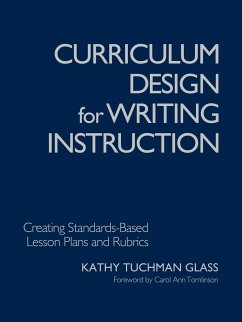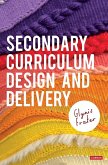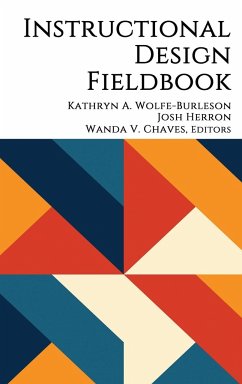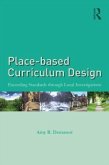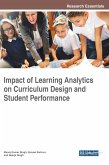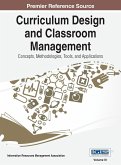Kathy Tuchman Glass, Katherine Tuchman Glass
Curriculum Design for Writing Instruction
Creating Standards-Based Lesson Plans and Rubrics
Kathy Tuchman Glass, Katherine Tuchman Glass
Curriculum Design for Writing Instruction
Creating Standards-Based Lesson Plans and Rubrics
- Broschiertes Buch
- Merkliste
- Auf die Merkliste
- Bewerten Bewerten
- Teilen
- Produkt teilen
- Produkterinnerung
- Produkterinnerung
From standards identification and translation to assessment, Glass leads the reader step-by-step through the writing process and the development of an effective standards-based writing curriculum. Using Glass' method, standards act as a solid foundation or framework, and teachers are encouraged to build as creatively upon that foundation as possible - designing lessons and units that are innovative, engaging, and which still produce measurable gains. Her four part process is as follows: 1. Identification of content-standards for writing: What do I want my students to know and be able to do? 2.…mehr
Andere Kunden interessierten sich auch für
![Secondary Curriculum Design and Delivery Secondary Curriculum Design and Delivery]() Glynis FraterSecondary Curriculum Design and Delivery96,99 €
Glynis FraterSecondary Curriculum Design and Delivery96,99 €![Curriculum Design and Classroom Management Curriculum Design and Classroom Management]() IrmaCurriculum Design and Classroom Management875,99 €
IrmaCurriculum Design and Classroom Management875,99 €![Instructional Design Fieldbook Instructional Design Fieldbook]() Instructional Design Fieldbook102,99 €
Instructional Design Fieldbook102,99 €![Place-based Curriculum Design Place-based Curriculum Design]() Amy B. DemarestPlace-based Curriculum Design74,99 €
Amy B. DemarestPlace-based Curriculum Design74,99 €![Secondary Curriculum Design and Delivery Secondary Curriculum Design and Delivery]() Glynis FraterSecondary Curriculum Design and Delivery37,99 €
Glynis FraterSecondary Curriculum Design and Delivery37,99 €![Impact of Learning Analytics on Curriculum Design and Student Performance Impact of Learning Analytics on Curriculum Design and Student Performance]() Impact of Learning Analytics on Curriculum Design and Student Performance184,99 €
Impact of Learning Analytics on Curriculum Design and Student Performance184,99 €![Curriculum Design and Classroom Management Curriculum Design and Classroom Management]() IrmaCurriculum Design and Classroom Management875,99 €
IrmaCurriculum Design and Classroom Management875,99 €-
-
-
From standards identification and translation to assessment, Glass leads the reader step-by-step through the writing process and the development of an effective standards-based writing curriculum. Using Glass' method, standards act as a solid foundation or framework, and teachers are encouraged to build as creatively upon that foundation as possible - designing lessons and units that are innovative, engaging, and which still produce measurable gains. Her four part process is as follows: 1. Identification of content-standards for writing: What do I want my students to know and be able to do? 2. Creating a teacher rubric with a clear set of criteria for writing assessment: What are the key criteria for achieving these standards and assessing students? 3. Crafting a student checklist to guide students through the unit and self-assess: What do students need to know and learn as they progress through the unit and how will they be assessed? 4. Designing lessons to achieve standards: How do I help my students meet the criteria? The numerous strategies, examples and photocopiables focus on writing at the primary level, but are easily adapted for use by secondary teachers of science and social studies.
Hinweis: Dieser Artikel kann nur an eine deutsche Lieferadresse ausgeliefert werden.
Hinweis: Dieser Artikel kann nur an eine deutsche Lieferadresse ausgeliefert werden.
Produktdetails
- Produktdetails
- Verlag: Corwin
- Seitenzahl: 268
- Erscheinungstermin: 1. Dezember 2004
- Englisch
- Abmessung: 280mm x 210mm x 15mm
- Gewicht: 664g
- ISBN-13: 9781412904568
- ISBN-10: 1412904560
- Artikelnr.: 21389951
- Herstellerkennzeichnung
- Libri GmbH
- Europaallee 1
- 36244 Bad Hersfeld
- gpsr@libri.de
- Verlag: Corwin
- Seitenzahl: 268
- Erscheinungstermin: 1. Dezember 2004
- Englisch
- Abmessung: 280mm x 210mm x 15mm
- Gewicht: 664g
- ISBN-13: 9781412904568
- ISBN-10: 1412904560
- Artikelnr.: 21389951
- Herstellerkennzeichnung
- Libri GmbH
- Europaallee 1
- 36244 Bad Hersfeld
- gpsr@libri.de
Consulting Description Kathy Glass is a former teacher who consults and presents nationally with K-12 teachers and administrators at schools, districts, conferences, and county offices of education. She offers a blend of professional development (PD) topics to target audiences in areas affecting curriculum and instruction. To deliver customized PD, she assists educators with strategic planning to determine objectives. Then she tailors PD based on requested topics such as, but not limited to: · highlights of the ELA Common Core Standards · implementation of the ELA Common Core or other standards-based curriculum using a backward design approach · essential understandings and guiding questions to frame curriculum and instruction · differentiated tools and instructional strategies · pre-, formative, summative, and self-assessments · alignment of six-traits writing instruction and assessment to curriculum goals · unit and yearlong curriculum maps · text-dependent questions to facilitate close reading, and more. To help educators directly translate what she presents into effective classroom practice that impacts students, Kathy can provide a variety of PD opportunities (e.g., presentations, lesson demonstrations and modeling, coaching, collaborative unit design, etc.). She is the author of six books: Mapping Comprehensive Units to the English Language (ELA) Arts Common Core Standards, 6-12 (May, 2013); Mapping Comprehensive Units to the ELA Common Core Standards, K-5 ((c) 2012); Lesson Design for Differentiated Instruction, Grades 4-9 ((c)2009); Staff Development Guide for the Parallel Curriculum ((c)2009); Curriculum Mapping: A Step-by-Step Guide to Creating Curriculum Year Overviews ((c)2007); and Curriculum Design for Writing Instruction: Creating Standards-Based Lesson Plans and Rubrics ((c)2005). In addition, Glass has served as a reader and reviewer for Reader's Handbook: A Student Guide for Reading and Learning (2002, Great Source Education Group) and as a contributing writer and consultant for the Heath Middle Level Literature series (1995, DC Heath and Co). Website: www.kathyglassconsulting.com; email: kathy@kathyglassconsulting.com
Foreword - Carol Ann Tomlinson
Acknowledgments
Introduction: The Tenets of Curriculum Design
Why Are Standards Important to Curriculum Design?
The Teacher Rubric (Scoring Guide) and Student Checklist Play a Crucial
Role
Two Scenarios: Curriculum Design Process Analogy
Curriculum Design Elements
Identify Grade Level Writing Standards
Create a Teacher Rubric With a Clear Set of Writing Criteria
Craft a Student Checklist to Guide Students and to State Objectives
Design Lessons to Achieve Standards
One More Connection to Drive Home the Point
1. Identify Grade Level Content Standards (Part 1)
Step-by-Step Details for Identifying Grade Level Content Standards
Target Writing Type (Application)
Identify Supporting Standards
Note Existing Lessons and Resources
Determine Timing of Unit
Standards Identification Samples
Personal Narrative/Fall (2nd grade)
Slavery Journal/Spring (8th grade)
2. Create/Revise a Rubric (Part 2)
Suggestions to Improve Writing Program
Create and Revise Rubrics
Collect Student Anchor Papers
Avoid Bias
Use Student Scores to Inform Your Instruction
Rubric Definition
Rubrics (Six Traits)
Rubric Sample and Elements
What Rubrics Are Included in This Chapter?
Do Teachers Need a Rubric for Each Assignment?
Do Students Use These Rubrics?
How Many Traits and Their Elements Are Included in a Writing Assignment?
Creating a Teacher Rubric for Your Targeted Writing Assignment
Step-by-Step Details for Designing a Rubric
Peruse Rubrics
Identify Elements for Each Trait
Compile All Elements to Create a Rubric
Revise Rubric Content
3. Craft a Student Checklist (Part 3)
Uses for Student Checklist
How to Introduce a Student Checklist
Students Use the Checklist to Guide Them While Writing
Step-by-Step Details for Creating a Student Checklist
Quick Review of Suggestions for Using a Checklist
4. Design/Refine Lessons (Part 4) and the Design Process at Work
Target Your Search to Find Lessons
Step-by-Step Details for Designing Lessons
Embrace Your Student Checklist Like a Friend
Search for Lessons
Organize Your Lessons in Sequential Order
Review Lessons
Select Student Samples
The Parts as a Whole: Comprehensive Lessons Utilizing the Complete
Process From Standards Identification to Actual Lessons
Single Paragraph Writing for Personal Character Description Using An
Anteater Named Arthur by Bernard Waber
Multi-Paragraph Writing for Personal Character Description Emphasizing
Detailed Examples to Support Personality Traits
Single- or Multi-Paragraph Writing for Fictitious Character Description
Focusing on Sensory Details
Response to Literature Expository Composition
5. Writing Process and Recordkeeping
Writing Process Steps
Revision Sheets
Recordkeeping
Whole Class Writing Performance Record
Individual Student Writing Performance Record
Emphasizing the Importance of Examining Student Work
6. Using the Curiculum Design Process for Science and Social Studies (and
Electives)
Standards and Worksheet Samples
Step-by-Step Process of How to Link Content (or Criteria) With Writing
Lessons
Miscellaneous Social Studies and Science Writing Activities and Projects
Writing Genre Suggestions
7. Time Saving Options for the Curriculum Design Process
Colleagues
Use a Rubric Only
Convert the Student Checklist Into a Scoring Mechanism
8. Reviewing the Steps in the Curriculum Design Process
Identify Grade Level Content Standards
Create/Revise Rubric
Craft a Student Checklist
Define or Revise Lessons
Resources
Theory, Research, Practice/Curriculum Design Models
Six Traits Support
Lessons, Activities, Assessments
Emphasis on Rubrics
Acknowledgments
Introduction: The Tenets of Curriculum Design
Why Are Standards Important to Curriculum Design?
The Teacher Rubric (Scoring Guide) and Student Checklist Play a Crucial
Role
Two Scenarios: Curriculum Design Process Analogy
Curriculum Design Elements
Identify Grade Level Writing Standards
Create a Teacher Rubric With a Clear Set of Writing Criteria
Craft a Student Checklist to Guide Students and to State Objectives
Design Lessons to Achieve Standards
One More Connection to Drive Home the Point
1. Identify Grade Level Content Standards (Part 1)
Step-by-Step Details for Identifying Grade Level Content Standards
Target Writing Type (Application)
Identify Supporting Standards
Note Existing Lessons and Resources
Determine Timing of Unit
Standards Identification Samples
Personal Narrative/Fall (2nd grade)
Slavery Journal/Spring (8th grade)
2. Create/Revise a Rubric (Part 2)
Suggestions to Improve Writing Program
Create and Revise Rubrics
Collect Student Anchor Papers
Avoid Bias
Use Student Scores to Inform Your Instruction
Rubric Definition
Rubrics (Six Traits)
Rubric Sample and Elements
What Rubrics Are Included in This Chapter?
Do Teachers Need a Rubric for Each Assignment?
Do Students Use These Rubrics?
How Many Traits and Their Elements Are Included in a Writing Assignment?
Creating a Teacher Rubric for Your Targeted Writing Assignment
Step-by-Step Details for Designing a Rubric
Peruse Rubrics
Identify Elements for Each Trait
Compile All Elements to Create a Rubric
Revise Rubric Content
3. Craft a Student Checklist (Part 3)
Uses for Student Checklist
How to Introduce a Student Checklist
Students Use the Checklist to Guide Them While Writing
Step-by-Step Details for Creating a Student Checklist
Quick Review of Suggestions for Using a Checklist
4. Design/Refine Lessons (Part 4) and the Design Process at Work
Target Your Search to Find Lessons
Step-by-Step Details for Designing Lessons
Embrace Your Student Checklist Like a Friend
Search for Lessons
Organize Your Lessons in Sequential Order
Review Lessons
Select Student Samples
The Parts as a Whole: Comprehensive Lessons Utilizing the Complete
Process From Standards Identification to Actual Lessons
Single Paragraph Writing for Personal Character Description Using An
Anteater Named Arthur by Bernard Waber
Multi-Paragraph Writing for Personal Character Description Emphasizing
Detailed Examples to Support Personality Traits
Single- or Multi-Paragraph Writing for Fictitious Character Description
Focusing on Sensory Details
Response to Literature Expository Composition
5. Writing Process and Recordkeeping
Writing Process Steps
Revision Sheets
Recordkeeping
Whole Class Writing Performance Record
Individual Student Writing Performance Record
Emphasizing the Importance of Examining Student Work
6. Using the Curiculum Design Process for Science and Social Studies (and
Electives)
Standards and Worksheet Samples
Step-by-Step Process of How to Link Content (or Criteria) With Writing
Lessons
Miscellaneous Social Studies and Science Writing Activities and Projects
Writing Genre Suggestions
7. Time Saving Options for the Curriculum Design Process
Colleagues
Use a Rubric Only
Convert the Student Checklist Into a Scoring Mechanism
8. Reviewing the Steps in the Curriculum Design Process
Identify Grade Level Content Standards
Create/Revise Rubric
Craft a Student Checklist
Define or Revise Lessons
Resources
Theory, Research, Practice/Curriculum Design Models
Six Traits Support
Lessons, Activities, Assessments
Emphasis on Rubrics
Foreword - Carol Ann Tomlinson
Acknowledgments
Introduction: The Tenets of Curriculum Design
Why Are Standards Important to Curriculum Design?
The Teacher Rubric (Scoring Guide) and Student Checklist Play a Crucial
Role
Two Scenarios: Curriculum Design Process Analogy
Curriculum Design Elements
Identify Grade Level Writing Standards
Create a Teacher Rubric With a Clear Set of Writing Criteria
Craft a Student Checklist to Guide Students and to State Objectives
Design Lessons to Achieve Standards
One More Connection to Drive Home the Point
1. Identify Grade Level Content Standards (Part 1)
Step-by-Step Details for Identifying Grade Level Content Standards
Target Writing Type (Application)
Identify Supporting Standards
Note Existing Lessons and Resources
Determine Timing of Unit
Standards Identification Samples
Personal Narrative/Fall (2nd grade)
Slavery Journal/Spring (8th grade)
2. Create/Revise a Rubric (Part 2)
Suggestions to Improve Writing Program
Create and Revise Rubrics
Collect Student Anchor Papers
Avoid Bias
Use Student Scores to Inform Your Instruction
Rubric Definition
Rubrics (Six Traits)
Rubric Sample and Elements
What Rubrics Are Included in This Chapter?
Do Teachers Need a Rubric for Each Assignment?
Do Students Use These Rubrics?
How Many Traits and Their Elements Are Included in a Writing Assignment?
Creating a Teacher Rubric for Your Targeted Writing Assignment
Step-by-Step Details for Designing a Rubric
Peruse Rubrics
Identify Elements for Each Trait
Compile All Elements to Create a Rubric
Revise Rubric Content
3. Craft a Student Checklist (Part 3)
Uses for Student Checklist
How to Introduce a Student Checklist
Students Use the Checklist to Guide Them While Writing
Step-by-Step Details for Creating a Student Checklist
Quick Review of Suggestions for Using a Checklist
4. Design/Refine Lessons (Part 4) and the Design Process at Work
Target Your Search to Find Lessons
Step-by-Step Details for Designing Lessons
Embrace Your Student Checklist Like a Friend
Search for Lessons
Organize Your Lessons in Sequential Order
Review Lessons
Select Student Samples
The Parts as a Whole: Comprehensive Lessons Utilizing the Complete
Process From Standards Identification to Actual Lessons
Single Paragraph Writing for Personal Character Description Using An
Anteater Named Arthur by Bernard Waber
Multi-Paragraph Writing for Personal Character Description Emphasizing
Detailed Examples to Support Personality Traits
Single- or Multi-Paragraph Writing for Fictitious Character Description
Focusing on Sensory Details
Response to Literature Expository Composition
5. Writing Process and Recordkeeping
Writing Process Steps
Revision Sheets
Recordkeeping
Whole Class Writing Performance Record
Individual Student Writing Performance Record
Emphasizing the Importance of Examining Student Work
6. Using the Curiculum Design Process for Science and Social Studies (and
Electives)
Standards and Worksheet Samples
Step-by-Step Process of How to Link Content (or Criteria) With Writing
Lessons
Miscellaneous Social Studies and Science Writing Activities and Projects
Writing Genre Suggestions
7. Time Saving Options for the Curriculum Design Process
Colleagues
Use a Rubric Only
Convert the Student Checklist Into a Scoring Mechanism
8. Reviewing the Steps in the Curriculum Design Process
Identify Grade Level Content Standards
Create/Revise Rubric
Craft a Student Checklist
Define or Revise Lessons
Resources
Theory, Research, Practice/Curriculum Design Models
Six Traits Support
Lessons, Activities, Assessments
Emphasis on Rubrics
Acknowledgments
Introduction: The Tenets of Curriculum Design
Why Are Standards Important to Curriculum Design?
The Teacher Rubric (Scoring Guide) and Student Checklist Play a Crucial
Role
Two Scenarios: Curriculum Design Process Analogy
Curriculum Design Elements
Identify Grade Level Writing Standards
Create a Teacher Rubric With a Clear Set of Writing Criteria
Craft a Student Checklist to Guide Students and to State Objectives
Design Lessons to Achieve Standards
One More Connection to Drive Home the Point
1. Identify Grade Level Content Standards (Part 1)
Step-by-Step Details for Identifying Grade Level Content Standards
Target Writing Type (Application)
Identify Supporting Standards
Note Existing Lessons and Resources
Determine Timing of Unit
Standards Identification Samples
Personal Narrative/Fall (2nd grade)
Slavery Journal/Spring (8th grade)
2. Create/Revise a Rubric (Part 2)
Suggestions to Improve Writing Program
Create and Revise Rubrics
Collect Student Anchor Papers
Avoid Bias
Use Student Scores to Inform Your Instruction
Rubric Definition
Rubrics (Six Traits)
Rubric Sample and Elements
What Rubrics Are Included in This Chapter?
Do Teachers Need a Rubric for Each Assignment?
Do Students Use These Rubrics?
How Many Traits and Their Elements Are Included in a Writing Assignment?
Creating a Teacher Rubric for Your Targeted Writing Assignment
Step-by-Step Details for Designing a Rubric
Peruse Rubrics
Identify Elements for Each Trait
Compile All Elements to Create a Rubric
Revise Rubric Content
3. Craft a Student Checklist (Part 3)
Uses for Student Checklist
How to Introduce a Student Checklist
Students Use the Checklist to Guide Them While Writing
Step-by-Step Details for Creating a Student Checklist
Quick Review of Suggestions for Using a Checklist
4. Design/Refine Lessons (Part 4) and the Design Process at Work
Target Your Search to Find Lessons
Step-by-Step Details for Designing Lessons
Embrace Your Student Checklist Like a Friend
Search for Lessons
Organize Your Lessons in Sequential Order
Review Lessons
Select Student Samples
The Parts as a Whole: Comprehensive Lessons Utilizing the Complete
Process From Standards Identification to Actual Lessons
Single Paragraph Writing for Personal Character Description Using An
Anteater Named Arthur by Bernard Waber
Multi-Paragraph Writing for Personal Character Description Emphasizing
Detailed Examples to Support Personality Traits
Single- or Multi-Paragraph Writing for Fictitious Character Description
Focusing on Sensory Details
Response to Literature Expository Composition
5. Writing Process and Recordkeeping
Writing Process Steps
Revision Sheets
Recordkeeping
Whole Class Writing Performance Record
Individual Student Writing Performance Record
Emphasizing the Importance of Examining Student Work
6. Using the Curiculum Design Process for Science and Social Studies (and
Electives)
Standards and Worksheet Samples
Step-by-Step Process of How to Link Content (or Criteria) With Writing
Lessons
Miscellaneous Social Studies and Science Writing Activities and Projects
Writing Genre Suggestions
7. Time Saving Options for the Curriculum Design Process
Colleagues
Use a Rubric Only
Convert the Student Checklist Into a Scoring Mechanism
8. Reviewing the Steps in the Curriculum Design Process
Identify Grade Level Content Standards
Create/Revise Rubric
Craft a Student Checklist
Define or Revise Lessons
Resources
Theory, Research, Practice/Curriculum Design Models
Six Traits Support
Lessons, Activities, Assessments
Emphasis on Rubrics

